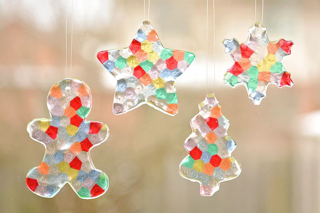When enough heat is added to a solid, it can melt into a liquid! Plastic beads at room temperature are round, with a hole in the middle, but if we put them into an oven – where the temperature is much higher – they melt into a liquid plastic. Liquids take the shape of their container so your heated round beads can now be formed into a new shape! Once the melted plastic is removed from the hot oven and cooled down in a freezer, the lower temperature makes the liquid return to a solid state.
Materials:
- Translucent Pony Beads
- Toothpick
- Metal Cookie Cutters
- Cookie Sheet
- Aluminum Foil
- String
- Hot Glue Gun (optional – if you want to glue the string to the ornament)
- Drill (optional – if you want to drill a hole for the string to loop through)
Activity:
Arrange your cookie cutters on a cookie sheet covered with aluminum foil. Pour some pony beads into each cookie cutter. Use a toothpick to stand all of the beads upright and completely fill the cookie cutter, removing any extra beads. Place the cookie sheet into a cold oven then bake at 450 degrees Fahrenheit for 8 to 11 minutes. (Note: Melting plastic can create an odor. If this is something that concerns you, consider taking a toaster oven outside.) When the beads have completely melted together without bubbling, remove the pan from the oven. Place the pan in the freezer for 10 minutes to cool. Gently pull the edges of the cookie cutter away from the plastic and push out each shape.
If you would like to turn your creation into an ornament for a Christmas tree or a decoration for your window, either use hot glue to attach a loop of string, or use a ⅛ inch drill bit to drill a hole through each of the ornaments.
Further Exploration:
- Can you name all four states of matter?
- What states of matter did you see with this activity?
- How might we change our matter into a gaseous state?
- What if we used metal beads? Would our oven at home be able to melt them into a liquid like it did with plastic? Why or why not?





